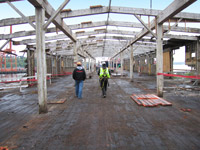Design for disassembly (DfD)
What is DfD?
DfD is a building design process that allows for the easy recovery of products, parts and materials when a building is disassembled or renovated. The process is intended to maximize economic value and minimize environmental impacts through reuse, repair, remanufacture and recycling. A DfD process involves developing the assemblies, components, materials, construction techniques, and information and management systems to accomplish this goal.
DfD is a growing phenomenon within manufacturing industries as greater attention is devoted to the management of the end-of-life of products. The effort is driven by the increasing disposal of large amounts of consumer goods, and the resulting pollution and the loss of materials and energy that these products contain.
The DfD building design process also addresses energy recovery from materials and safe bio-degradation. DfD enables flexibility, convertibility, addition, and subtraction of whole-buildings. In this manner DfD may help avoid the removal of buildings altogether.

DfD guide
The DfD guideDownload PDF 1.0 MB is an introduction to the principles, methods, and materials of Design for Disassembly in the built environment. It is intended for owners, architects, designers and builders, and we hope it will help facilitate investigations and incorporation of this important aspect of sustainable design and building.
DfD – Distilled down to 14 basic questions
It is strongly recommended that you read the full DfD Guide but if you haven't the time please ask yourself the following fourteen questions as you sit down to work on yourlatest project. You might even want to print these out and post them at your work station.
- How long will the building last?
- How easily can the building be transitioned to different uses?
- What will happen to the building when it has reached the end of its life?
- How easy will the building be to maintain?
- How efficient will the building be (energy, water, human, etc.)?
- How adaptable will the building be to changing local climate conditions?
- Will the people taking the building down in 100 years know how to disassemble the building? Will the tools to do so be readily available?
- What connections are used between all the different building elements? How easy are they to undo?
- Will people who use the building like it?
- How toxic will the buildings materials be?
- How long will the different layers last?
- How many different materials are going into the building?
- Who else has been asked to think and provide input on these issues?
- How will the mechanical, electrical, and plumbing systems be run through or attached to the building? Can these systems be minimized?


 Translate
Translate
